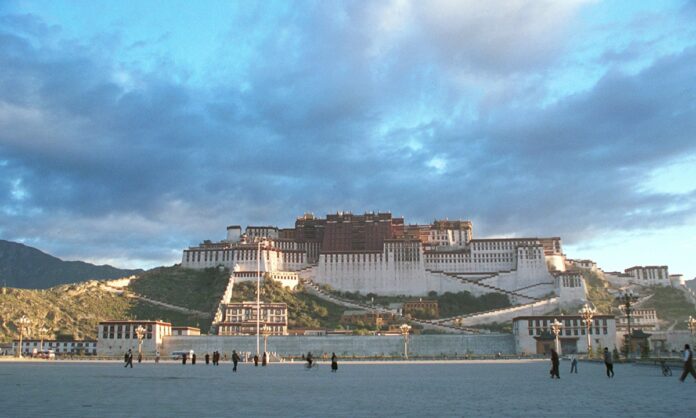The view of Potala Palace in Lhasa city, Southwest China’s Xizang Autonomous Region. Photo: IC
Urumqi of Northwest China’s Xinjiang Uygur Autonomous Region and Ngari Prefecture of Southwest China’s Xizang (Tibet) Autonomous – two of most popular tourism destinations in China – on Wednesday escalated their COVID-19 response levels by imposing “static management” in a bid to contain this wave of COVID-19 resurgence.
Observers believed that climbing daily cases will deal a certain blow to China’s tourist industry in August, due to some popular destinations being hit by COVID-19, from previously affected Guangxi, Inner Mongolia and Gansu to the recent cases in Hainan, Xinjiang and Xizang. But they believed the overall enthusiasm for summer travel has not decreased and in the long run, public confidence in domestic travel will rise since the country’s epidemic measures are more precise and science-based.
In a notice on Wednesday, Xizang’s Ngari Prefecture said the region will impose static management for three days starting from Thursday, encouraging tourists and residents to stay put during the period. Supermarkets and banks can shorten their operation hours and public amusement venues will be closed.
Previously, the cities of Lhasa, capital of Xizang region and Xigaze have imposed static management. The entire Xizang registered 54 COVID-19 cases as of Wednesday.
While in Xinjiang region, the COVID-19 situation is still grim. On Wednesday, the 11th day since the region reported a COVID-19 case, Urumqi, capital city of the Xinjiang region, partially suspended public transportation and closed off residential communities for five days as 27 cases were detected. The Urumqi airport operated normally on Wednesday and it also arranged free buses to evacuate tourists.
As of 9 pm on Wednesday, Xinjiang region has zero confirmed cases and 776 asymptomatic infections.
Since this wave of sudden flare-ups comes at a time when the nation’s tourism sector is at its annual peak, it has halted trips by millions of tourists. The Global Times found at least 18 places in six provincial-level regions are under static management.
In a description of the COVID-19 big picture across the country, Mi Feng, the spokesperson of the National Health Commission (NHC), said at Wednesday’s press conference that so far in August, China has had nine provinces that have registered COVID-19 cases surpassing 100.
The recent COVID-19 outbreaks in multiple Chinese tourist hot spots in such a high season will deal a hard blow to China’s tourist industry in 2022, especially since the static management in some places has hit the confidence of would-be tourists who planned trans-regional trips in the short term, some tourism insiders told the Global Times.
But Han Jie, the head of YTS Aoyou Travel Technology Development, told the Global Times on Wednesday that as the country’s precise and scientific COVID-19 measures continue to roll out and the circuit-breaker mechanism for cross-provincial trips can precisely target individual counties, tourists’ confidence is actually rebounding.
In epidemic-hit regions, we saw rising group tours and customized orders get canceled. Meanwhile, we have seen a rise in short trips to the suburbs and neighboring cities and other unaffected regions for travel. So that overall, the public enthusiasm for summer travel has not decreased, Han noted.
As a precautionary move, a number of Chinese tourist destinations that have not experienced epidemics have introduced measures to strengthen their epidemic prevention. Dalian in Northeast China’s Liaoning Province asked new arrivals to undergo a free nucleic acid test. If they fail to receive one within 48 hours, they may be persuaded to leave the city.
Though facing unprecedented COVID-19 pressure, the tourism market is not necessarily at an entire standstill. Lu Hongzhou, head of the Third People’s Hospital of Shenzhen, said the key is to confine the epidemic to a certain scope once there is one, stressing the importance of implementing an “early finding” mechanism in crowded tourism sites.
Dong Xiaoping, a chief virologist from the Chinese Center for Disease Control and Prevention, told Wednesday’s press conference that based on precise and scientific measures, epidemic-hit regions are able to cope with this wave of resurgence.
It also indicates that China’s ninth version of the COVID-19 playbook that was newly adjusted in June is still effective for Omicron variants, Dong said.
Since August, six variants have emerged across China, and most are variant BA.5 mutations, according to media reports. Dong added that compared with variant BA.2, variant BA.5 has slightly higher transmission and significantly enhanced immune escape ability, which could increase the risk of re-infection, posing greater challenges to the country’s COVID-19 handling.
In response to public concerns over Xizang’s handling of COVID-19, Guo Yanhong, an official from the NHC, said at the press conference that Xizang has the ability to cope with COVID-19 flare-ups. She revealed that the State Council, China’s cabinet, has dispatched COVID-19 working groups composed of testing staff, medical experts and epidemiologists to Xizang.
To help Hainan, which has reported more than 2,000 cases so far, Guo said more than 10,000 medical and health workers from 19 provinces and municipalities have been dispatched to the province, expressing confidence toward its handling of COVID-19.










